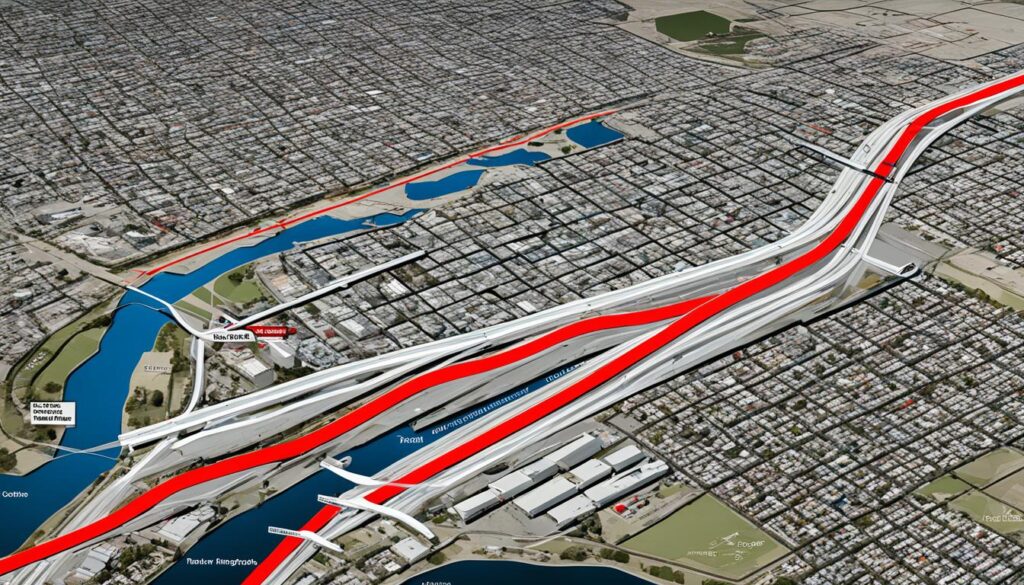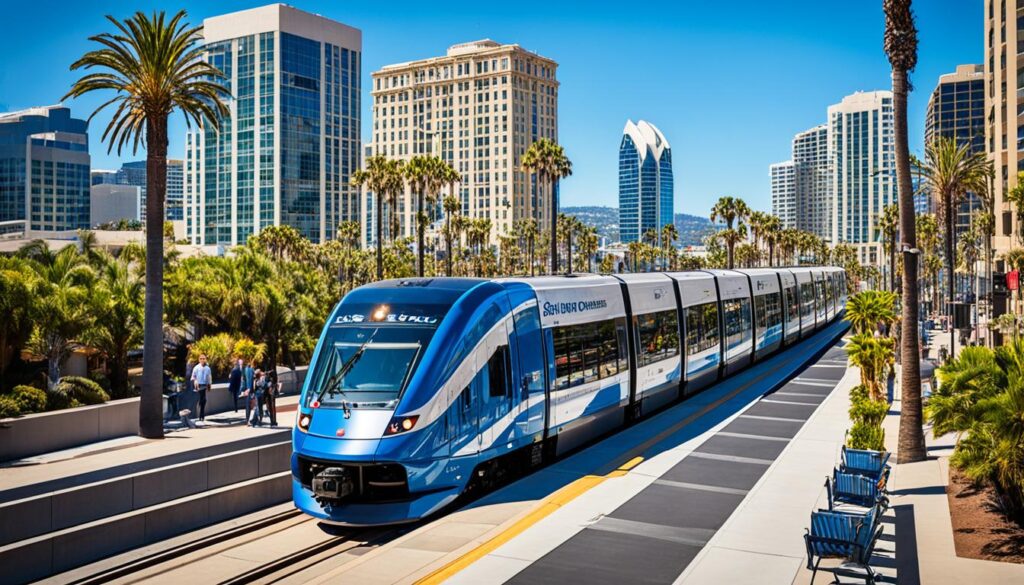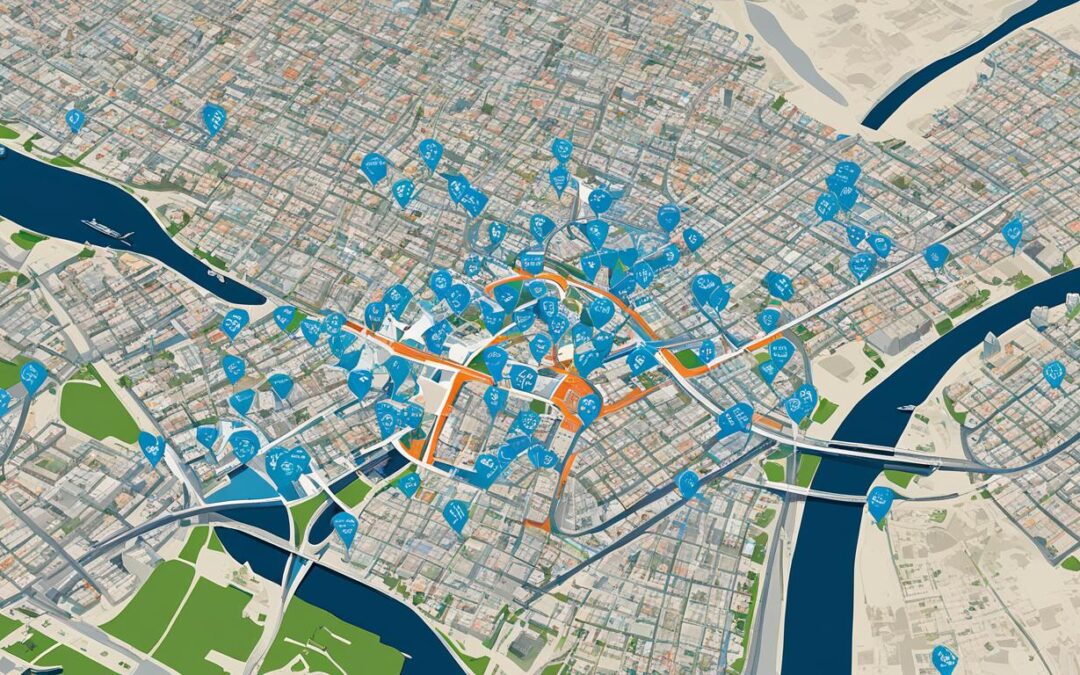Did you know that proximity to transport has a significant impact on property values in San Diego?
Living near public transportation or transit hubs can greatly influence the real estate market and urban development in the city. With the recent policy changes allowing for higher density development near mass transit, San Diego is taking steps to address its affordable housing crisis and promote transit-oriented development.
Key Takeaways:
- Proximity to transport has a significant impact on San Diego property values and trends in real estate.
- Recent policy changes are encouraging higher density development near mass transit to address the city’s affordable housing crisis.
- Transit-oriented development is a key focus, with the aim of stimulating urban redevelopment and mixed-use projects.
- Proximity to high-capacity transit modes can result in a transit premium and increased property values.
- However, achieving the full potential of increased property value may require complementary infrastructure and a supportive regulatory environment.
The Economic Impact of the San Diego Metropolitan Transit System
A study conducted by the Fermanian Business & Economic Institute reveals the significant economic impact of the San Diego Metropolitan Transit System (MTS) on the region. In FY 2018 alone, MTS-related activities generated an estimated $1.0 billion of gross regional product (GRP) and supported nearly 13,000 jobs. The San Diego Metropolitan Transit System not only plays a crucial role in providing efficient public transportation but also makes significant contributions in terms of environmental sustainability and cost savings for its riders.
MTS has made remarkable strides in reducing the area’s carbon footprint by cutting CO2 emissions by 97,000 metric tons in FY 2018. This reduction translates into environmental savings amounting to $13.6 million. By offering a reliable alternative to private vehicles, MTS has contributed to mitigating air pollution and helping combat climate change.
In addition to environmental benefits, the San Diego Metropolitan Transit System has been instrumental in providing significant savings for its riders. It is estimated that in FY 2018, San Diego residents saved a total of approximately $861 million by utilizing MTS services instead of relying on private transportation. These savings result from reduced expenses on vehicle ownership, maintenance, fuel, parking fees, and other associated costs.
While the economic impact of the San Diego Metropolitan Transit System is evident, it is important to note that MTS ridership has experienced some fluctuations in recent years. Although there was a slight decline, there has been a promising increase in ridership during FY 2019. This data suggests a positive trend and highlights the ongoing importance of public transportation in the region.
By positively impacting the local economy, reducing the carbon footprint, and providing substantial cost savings to its riders, the San Diego Metropolitan Transit System is a vital component of the city’s transportation infrastructure. Its continued growth and improvement will not only benefit the individuals who rely on public transit but will also contribute to a sustainable and prosperous future for San Diego as a whole.

MTS Economic Impact: Key Figures
| MTS Economic Impact (FY 2018) | Amount |
|---|---|
| Gross Regional Product (GRP) Generated | $1.0 billion |
| Jobs Supported | Approximately 13,000 |
| CO2 Emissions Reduced | 97,000 metric tons |
| Environmental Savings | $13.6 million |
| Total Savings for Riders | Approximately $861 million |
The Influence of Proximity to Transport on Property Values
Proximity to high-capacity transit, also known as transit-oriented development (TOD), can have a significant impact on property values. Studies have shown that properties near high-capacity transit lines and stations can experience a “transit premium” of up to 150%. However, the extent of this premium depends on factors such as the local regulatory environment, regional connections, and national and regional economics.
High-capacity transit modes, including commuter rail, metro rail, light rail, and bus rapid transit, are most likely to generate a development response and increased land values. TOD has been credited with significant urban redevelopment benefits and can be a catalyst for mixed-use projects at higher densities, although this may involve higher development costs and risks.
Benefits of Transit-Oriented Development (TOD)
- Increased property values near high-capacity transit lines and stations
- Urban redevelopment and revitalization
- Promotion of sustainable transportation options
- Support for mixed-use projects and higher densities
- Reduction in dependency on private vehicles
“Transit-oriented development has the potential to transform communities, offering residents convenient access to transportation options while creating vibrant, walkable neighborhoods.” – Jane Jacobs
Transit-oriented development can play a crucial role in shaping the San Diego real estate market. It not only improves accessibility to transportation modes but also contributes to sustainable urban development. The availability of high-capacity transit options can attract developers, investors, and homebuyers, leading to increased property values and economic growth in the area.

By integrating transportation infrastructure and land use planning, transit-oriented development promotes efficient and convenient mobility, reducing the need for long commutes and private vehicle usage. This, in turn, can have a positive impact on traffic congestion, air quality, and overall livability in the city.
The San Diego real estate market stands to benefit from embracing transit-oriented development strategies and leveraging the transit premium that high-capacity transit can provide. As the city continues to invest in transportation infrastructure and explore innovative solutions, the influence of proximity to transport on property values will remain a key consideration for both buyers and developers in the San Diego real estate market.
Conclusion
The San Diego property market is greatly influenced by proximity to transportation, with recent policy changes demonstrating the city’s commitment to addressing the affordable housing crisis through transit-oriented development. The economic impact of the San Diego Metropolitan Transit System further underscores the significance of public transportation in the region’s urban development.
Proximity to high-capacity transit not only increases property values but also serves as a catalyst for stimulating development, particularly through transit-oriented development (TOD). However, the extent of the transit premium depends on various factors such as regional connections and economic conditions.
While the potential for increased property value is evident, realizing its full potential may require complementary infrastructure investments and a supportive regulatory environment. Both buyers and developers in San Diego’s real estate market should consider the influence of proximity to transport when making investment decisions.
FAQ
How does proximity to transport impact San Diego property?
Proximity to transport can have a significant impact on San Diego property values. Studies have shown that properties near high-capacity transit lines and stations can experience a “transit premium” of up to 150%. This means that the value of the property can increase by as much as 150% due to its proximity to public transportation.
What is transit-oriented development (TOD) in San Diego?
Transit-oriented development (TOD) refers to the development of properties near high-capacity transit lines and stations. It focuses on creating mixed-use projects at higher densities, which can stimulate urban redevelopment and increase property values. TOD is seen as a way to address the affordable housing crisis in San Diego by providing more housing options near public transportation.
How does transportation infrastructure impact property value in San Diego?
A well-developed transportation infrastructure, including high-capacity transit modes such as commuter rail, metro rail, light rail, and bus rapid transit, can increase property values in San Diego. The availability and convenience of public transportation options make properties more desirable and can attract buyers and developers.
Does San Diego public transportation influence property values?
Yes, public transportation in San Diego can influence property values. Proximity to high-capacity transit lines and stations can increase property values due to the convenience and accessibility they offer. Properties near public transportation are often in high demand, resulting in higher selling prices and potential investment opportunities.
What is the impact of the San Diego Metropolitan Transit System on the region?
The San Diego Metropolitan Transit System (MTS) has a significant economic impact on the region. In FY 2018, MTS-related activities generated approximately
FAQ
How does proximity to transport impact San Diego property?
Proximity to transport can have a significant impact on San Diego property values. Studies have shown that properties near high-capacity transit lines and stations can experience a “transit premium” of up to 150%. This means that the value of the property can increase by as much as 150% due to its proximity to public transportation.
What is transit-oriented development (TOD) in San Diego?
Transit-oriented development (TOD) refers to the development of properties near high-capacity transit lines and stations. It focuses on creating mixed-use projects at higher densities, which can stimulate urban redevelopment and increase property values. TOD is seen as a way to address the affordable housing crisis in San Diego by providing more housing options near public transportation.
How does transportation infrastructure impact property value in San Diego?
A well-developed transportation infrastructure, including high-capacity transit modes such as commuter rail, metro rail, light rail, and bus rapid transit, can increase property values in San Diego. The availability and convenience of public transportation options make properties more desirable and can attract buyers and developers.
Does San Diego public transportation influence property values?
Yes, public transportation in San Diego can influence property values. Proximity to high-capacity transit lines and stations can increase property values due to the convenience and accessibility they offer. Properties near public transportation are often in high demand, resulting in higher selling prices and potential investment opportunities.
What is the impact of the San Diego Metropolitan Transit System on the region?
The San Diego Metropolitan Transit System (MTS) has a significant economic impact on the region. In FY 2018, MTS-related activities generated approximately $1.0 billion of gross regional product (GRP) and supported nearly 13,000 jobs. MTS also contributed to reducing the region’s carbon footprint by reducing CO2 emissions by 97,000 metric tons, resulting in an environmental savings of $13.6 million. Additionally, MTS provided significant savings to its riders, totaling an estimated $861 million in FY 2018.
The trend in San Diego property values suggests that proximity to transportation is an important consideration for buyers and developers. The shift towards transit-oriented development and the city’s commitment to addressing the affordable housing crisis demonstrate the value placed on transportation proximity. As more people recognize the benefits of living near public transportation, demand for properties in these areas is expected to increase, potentially leading to further property value appreciation.
How can high-capacity transit influence property values in San Diego?
High-capacity transit modes, such as commuter rail, metro rail, light rail, and bus rapid transit, are most likely to generate a “transit premium” and increased land values. The convenience and accessibility provided by these modes of transport make properties near them more desirable. Developers may also be more inclined to invest in areas with high-capacity transit, leading to more development and potential increases in property value.
.0 billion of gross regional product (GRP) and supported nearly 13,000 jobs. MTS also contributed to reducing the region’s carbon footprint by reducing CO2 emissions by 97,000 metric tons, resulting in an environmental savings of .6 million. Additionally, MTS provided significant savings to its riders, totaling an estimated 1 million in FY 2018.
The trend in San Diego property values suggests that proximity to transportation is an important consideration for buyers and developers. The shift towards transit-oriented development and the city’s commitment to addressing the affordable housing crisis demonstrate the value placed on transportation proximity. As more people recognize the benefits of living near public transportation, demand for properties in these areas is expected to increase, potentially leading to further property value appreciation.
How can high-capacity transit influence property values in San Diego?
High-capacity transit modes, such as commuter rail, metro rail, light rail, and bus rapid transit, are most likely to generate a “transit premium” and increased land values. The convenience and accessibility provided by these modes of transport make properties near them more desirable. Developers may also be more inclined to invest in areas with high-capacity transit, leading to more development and potential increases in property value.


Recent Comments